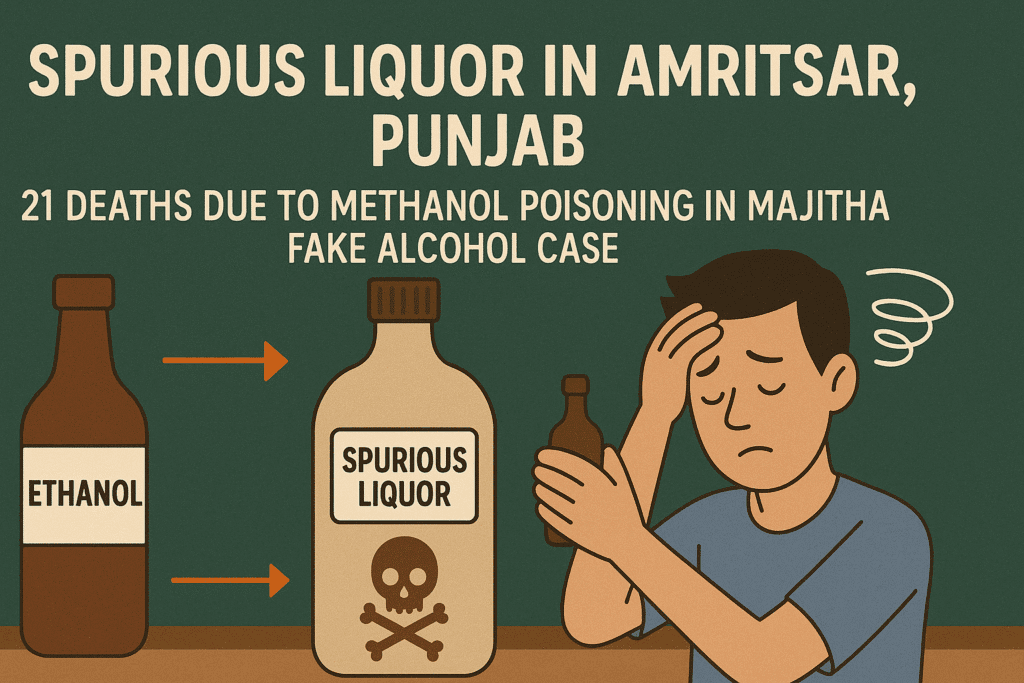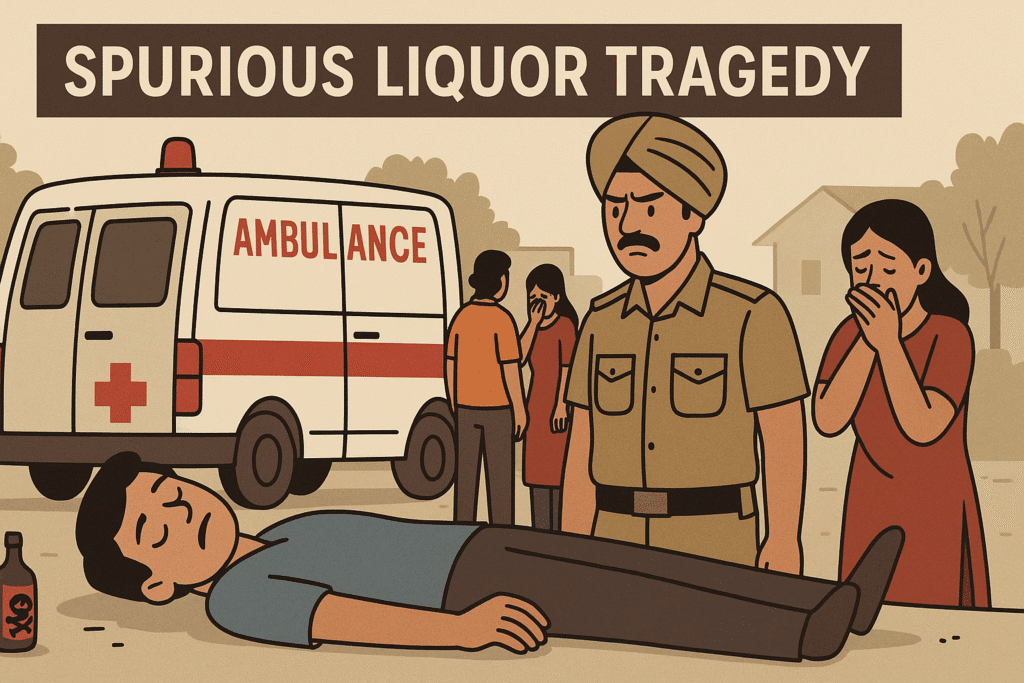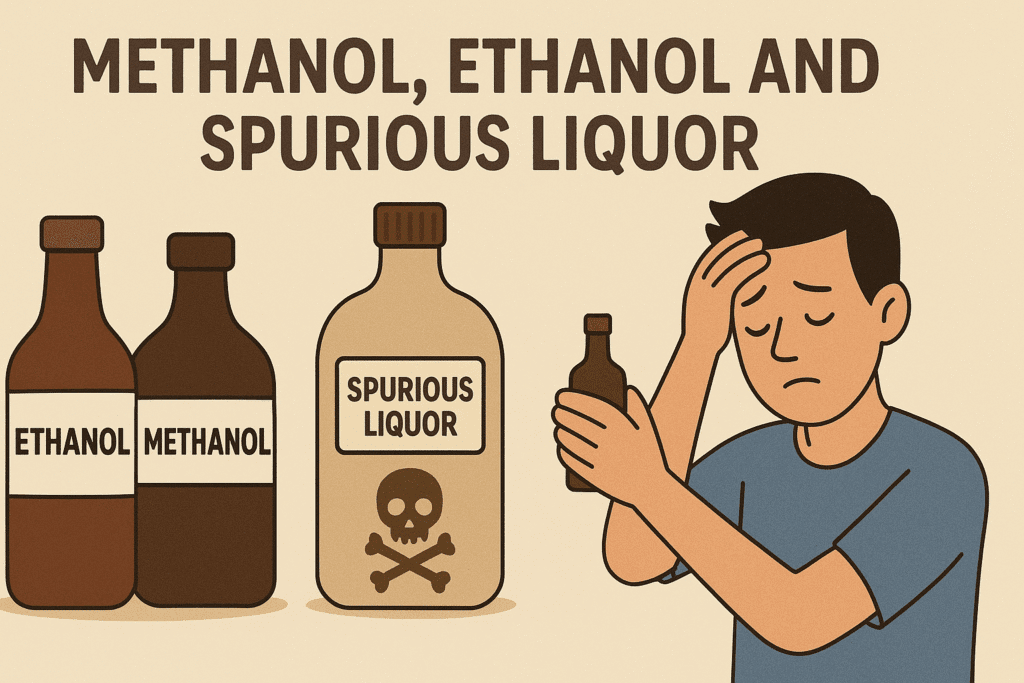
In a sad event, 21 men died after drinking spurious liquor in some villages of the Majitha area . This has again shown how dangerous methanol-mixed alcohol can be. Some people add methanol to homemade or illegal liquor because it is cheap and helps them earn more profit.
Now let us understand what methanol is, why it is harmful , and how it can cause death.
Table of Contents

What is Alcohol?
Alcohol refers to a group of organic chemical compounds. There are several types of alcohols, but only one — ethanol — is safe for human consumption in limited amounts. Ethanol is found in alcoholic beverages like beer, wine, and whisky.
However, methanol is a different type of alcohol that is toxic (poisonous) to humans. Even small amounts can lead to serious health issues or death.
🔹 To explore more articles on English Grammar and strengthen your language skills for competitive exams, click here.
What is Methanol?
Methanol, also known as wood alcohol , is a clear, colorless liquid with a mild alcoholic odor. It is often used in industrial processes, not for human consumption.
Common Uses of Methanol:
- As fuel in engines and industrial boilers
- In the production of formaldehyde (used in making plastics and resins)
- As a solvent in paints, varnishes, and thinners
- In the manufacturing of adhesives, plywood, and synthetic fabrics
Despite its usefulness in industry, methanol is extremely harmful if ingested .
How Does Methanol Cause Death?
When methanol enters the body, it is metabolized (broken down) by the liver into formaldehyde and then into formic acid . These substances are highly toxic and can cause severe damage to cells and tissues.
Effects on the Body:
- Central Nervous System Damage :
Methanol affects the brain and spinal cord, leading to symptoms such as dizziness, headache, confusion, seizures, coma, and even death. - Vision Loss or Blindness :
One of the most well-known effects of methanol poisoning is damage to the optic nerve, which can result in blurred vision, permanent blindness, or total loss of sight. - Metabolic Acidosis :
Formic acid builds up in the blood, making it too acidic. This condition, called metabolic acidosis , can disrupt normal body functions and lead to organ failure. - Organ Failure :
The kidneys, liver, and heart may fail due to the buildup of toxins, ultimately causing death.
Even a small amount — as little as 10 ml (about two teaspoons) — can cause blindness, and 30 ml or more can be fatal.
🔹 For more insightful articles and updates on current affairs, feel free to explore our website through this link.
Why Is Methanol Used in Spurious Liquor?

Some unscrupulous sellers mix methanol with ethanol to reduce production costs and increase profits. Since methanol is cheaper than ethanol and looks similar, it becomes an attractive option for illegal manufacturers who do not care about human life.
This is especially common in unlicensed or homemade liquor , where quality checks are absent.
🔹 Explore the vibrant history and culture of Punjab, from its ancient roots to its modern traditions, by diving into our detailed articles—click here to learn more!
Recent Tragedy in Majitha Area
In this recent case, 21 men died after drinking spurious liquor laced with methanol in some villages of the Majitha area . Many others were hospitalized in critical condition.
Such tragedies highlight the urgent need for better regulation, strict enforcement of laws against spurious liquor trade, and awareness among people about the risks of consuming unbranded or spurious liquor.
🔹 Master the fundamentals of Punjabi grammar with our comprehensive guides and resources—click here to enhance your understanding of syntax, vocabulary, and linguistic nuances!
How Can We Prevent Such Deaths?
- Strict Enforcement of Laws :
Crackdowns on illegal liquor manufacturing and distribution are essential. - Public Awareness Campaigns :
People should be educated about the dangers of spurious liquor and the importance of buying licensed products. - Better Healthcare Access :
Quick medical help, including antidotes like ethanol or fomepizole , can save lives if given immediately after suspected methanol poisoning. - Legal Reforms :
Harsher punishments for those involved in selling toxic liquor can act as a deterrent.
Summary Table for Competitive Exams
| Topic | Details |
|---|---|
| Chemical Name of Methanol | CH₃OH |
| Safe Alcohol for Humans | Ethanol |
| Toxic Byproducts of Methanol | Formaldehyde, Formic Acid |
| Fatal Dose of Methanol | 30 ml or more |
| Common Symptoms | Headache, Vomiting, Blurred Vision, Coma |
| Cause of Death | Organ failure, Metabolic acidosis |
| Use of Methanol | Industrial (fuel, paint, plastic industries) |
| Why Used in Fake Liquor? | Cheaper than ethanol |
| Prevention Methods | Regulation, Public awareness, Legal action |
The Majitha tragedy serves as a grim reminder of the deadly consequences of methanol poisoning(Spurious Liquor) through spurious liquor. For aspirants of competitive exams like UPSC, PCS, and other state-level exams , understanding the science behind such incidents is crucial, especially for questions related to public health, governance, science & technology, and current affairs .
Being aware of the dangers of methanol and knowing how to prevent such tragedies helps build a safer and more informed society.
Important Vocabulary for Students:
- Spurious Liquor – Fake or not genuine alcohol
- Toxic – Poisonous
- Metabolized – Broken down in the body
- Formaldehyde – A toxic chemical formed from methanol
- Metabolic Acidosis – Build-up of acid in the blood
- Antidote – A medicine used to counteract poison
- Illicit – Illegal
- Deterrent – Something that prevents wrongdoing
By learning these terms and concepts, students can write better answers in exams and improve their general knowledge.
Punjab General Knowledge for Competitive Exams
1. Basic Information
| Topic | Details |
|---|---|
| Full Name | Punjab (The Land of Five Rivers) |
| Capital | Chandigarh (shared with Haryana) |
| Formation Day | November 1, 1966 (under the Punjab Reorganisation Act) |
| Language | Punjabi (official language) |
| State Animal | Blackbuck |
| State Bird | Northern Goshawk |
| State Flower | Night-flowering Jasmine (Raat Rani) |
| State Tree | Indian Rosewood (Sheesham) |
2. Geography
- Location : Northwestern India
- Area : 50,362 sq km (1.5% of India’s total area)
- Borders :
- North: Jammu & Kashmir
- West: Pakistan
- South: Rajasthan
- East: Himachal Pradesh and Haryana
- Rivers : Beas, Sutlej, Ravi (three of the five rivers after which Punjab is named; the other two — Chenab and Jhelum — are now in Pakistan)
3. Economy and Agriculture
Punjab is known as the “Granary of India” due to its rich agricultural output.
- Main Crops :
- Wheat – Major contributor to national food security
- Rice (Paddy) – Widely cultivated
- Cotton, Maize, Sugarcane, Mustard
- Green Revolution :
- Punjab played a central role during the Green Revolution in the 1960s
- Known for high productivity of wheat and rice
- Industrial Growth :
- Growing sectors include textiles, food processing, and auto components
- Ludhiana is known for cycle parts and hosiery industries
4. Culture and Festivals
- Festivals :
- Baisakhi – Most important festival; marks the beginning of the Sikh New Year and the formation of the Khalsa Panth
- Hola Mohalla – Celebrated by Sikhs with martial arts displays
- Gurpurabs – Birth anniversaries of Sikh Gurus
- Lohri – Celebrated in winter before Makar Sankranti
- Diwali and Holi – Also widely celebrated
- Folk Dances :
- Bhangra (male)
- Gidda (female)
- Jhummar , Sammi , Kikli
- Music Instruments :
- Dhol, Tumbi, Algoza, Chimta
5. Historical Importance
- Indus Valley Civilization : Areas of Punjab were part of this ancient civilization.
- Ancient Name : “Sapta Sindhu” (Land of Seven Rivers)
- Important Historical Sites :
- Harappa (in present-day Pakistan, but majorly linked with Punjab history)
- Anandpur Sahib – Founded by Guru Tegh Bahadur
- Golden Temple (Harmandir Sahib) – Spiritual center of Sikhism in Amritsar
- Sikh Empire :
- Founded by Maharaja Ranjit Singh in the 18th century
- Capital: Lahore (now in Pakistan)
6. Governance and Administration
- Governor : Appointed by the President of India
- Chief Minister : Head of government; currently [Insert Current CM’s Name]
- Legislature : Unicameral (only one house – Punjab Legislative Assembly)
- Assembly Seats : 117
- Lok Sabha Seats : 13
- Rajya Sabha Seats : 7
7. Education and Important Institutions
- Panjab University – Located in Chandigarh
- Punjabi University – Patiala
- SGT Bhai Vir Singh Sahitya Sadan – Promotes Punjabi literature
- Central University of Punjab – Bathinda
8. Tourist Attractions
| Place | Description |
|---|---|
| Amritsar | Golden Temple, Jallianwala Bagh, Wagah Border |
| Anandpur Sahib | Religious and historical significance for Sikhs |
| Ludhiana | Industrial hub, Lodhi Fort |
| Chandigarh | Shared capital, known for architecture and gardens |
| Kesgarh Sahib | One of the Five Takhts of Sikhism |
| Mansa | Folk heritage and cultural festivals |
